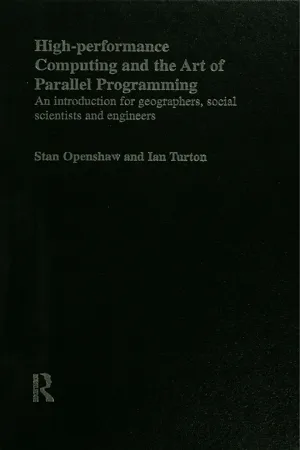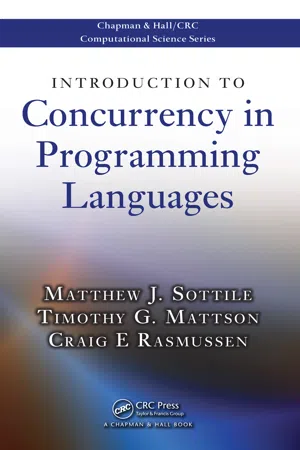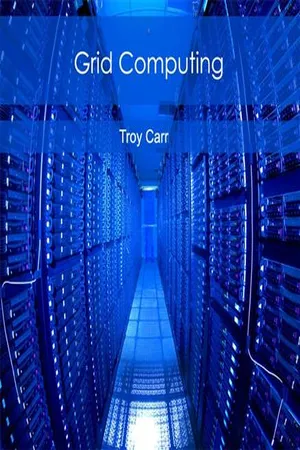Computer Science
Concurrency Vs Parallelism
Concurrency refers to the ability of a system to handle multiple tasks at the same time, often through interleaving execution. Parallelism, on the other hand, involves simultaneously executing multiple tasks by utilizing multiple resources. In essence, concurrency is about dealing with many things at once, while parallelism is about doing many things at once.
Written by Perlego with AI-assistance
Related key terms
1 of 5
10 Key excerpts on "Concurrency Vs Parallelism"
- eBook - ePub
High Performance Computing and the Art of Parallel Programming
An Introduction for Geographers, Social Scientists and Engineers
- Stan Openshaw, Ian Turton(Authors)
- 2005(Publication Date)
- Routledge(Publisher)
p. 6 );while Krishnamurthy (1989) writes‘A simple-minded approach to gain speed, as well as power, in computing is through parallelism; here many computers would work together, all simultaneously executing some portions of a procedure used for solving a problem’ (p. 1 ).The key common point is to note that parallel processing is the solution of a single problem by using more than one processing element (or processor or node or processing element or CPU). This feat can be achieved in various ways: indeed, parallel programming is all about discovering how to program a computer with multiple CPUs in such a way that they can all be used with maximum efficiency to solve the same problem. This is how we would define it and it is good to know that the experts all agree.However, it is important not to overemphasise the parallel bit, because it is not really all that novel or new! Indeed, parallelism is widely used, albeit on a small scale, in many computer systems that would not normally be regarded as being parallel processor hardware. Morse (1994) writes: ‘If by parallel we mean concurrent or simultaneous execution of distinct components then every machine from a $950 PC to a $30 million Cray C-90 has aspects of parallelism’ (p. 4 ). The key distinction is whether or not the parallelism is under the user’s control or is a totally transparent (i.e. invisible) part of the hardware that you have no explicit control over and probably do not know that it even exists. It is only the former sort that we need worry about since it is this which we would like to believe is under our control.3.1.2 Jargon ILike many other areas of technology, parallel computing is a subject with some seemingly highly mysterious jargon of its own. Yet it occurs so often that you really do need to memorise at least some of it and either know in general terms what it all means or know sufficient so that you may successfully guess the rest. There are the various words or abbreviations that previously you may have either never come across or never really understood what they mean. You will never be able to join in the small talk at an HPC conference bar unless you master the basic vocabulary and terminology! So here goes. - Adele Kuzmiakova(Author)
- 2023(Publication Date)
- Arcler Press(Publisher)
Co-processes and predictable concurrency are two concurrent computing methods. In such architectures, Fundamentals of Concurrent, Parallel, and Distributed Computing 5 controlling thread expressly hand over their different activities and tasks to the systems or the other program (Angus et al., 1990). Concurrency refers to the simultaneous execution of numerous calculations. Whether we like it or not, parallelism is omnipresent in contemporary program development (Aschermann et al., 2018), as indicated by the presence of: • A system is a group of linked computers; • Apps which are operating simultaneously on the same machine; • A system with large multiple processors. Concurrency is, in fact, critical in contemporary coding (Pomello, 1985), as demonstrated by these facts: • Sites must be able to manage several users at the same time; • Several of the programming for mobile applications must be done on databases (“inside the clouds”). A software tool often requires a backstage operation that does not disrupt the user. Horizon, for example, constructs your Programming language as you operate on it (Agha and Hewitt, 1987). Parallel processing will remain important in the future. Maximum clock rates are not increasing anymore. Rather, we get more processing with each new generation of contemporary CPUs. As a result, shortly, we will have to partition a computation into many concurrent bits to keep it running faster (Fernandez et al., 2012). 1.2.1. Two Models for Concurrent Programming Simultaneous processing is usually done using one of two approaches: identify a specific or message forwarding (Figure 1.2) (Ranganath and Hatcliff, 2006). Figure 1.2. Memories that are linked. Source: https://web.mit.edu/6.005/www/fa14/classes/17- concurrency/#:~:text=There%20are%20two%20common%20 models,shared%20memory%20and%20message%20passing.- eBook - PDF
- Arvind Kumar Bansal(Author)
- 2013(Publication Date)
- Chapman and Hall/CRC(Publisher)
275 C H A P T E R 8 Concurrent Programming Paradigm BACKGROUND CONCEPTS Abstract concepts in computation (Section 2.4); Abstractions and information exchange (Chapter 4); Control abstractions (Section 4.2); Discrete structure concepts (Section 2.2); Grammar (Section 3.2); Graphs (Section 2.3.6), Principle of locality (Section 2.4.8), Nondeterministic computation (Section 4.7); Operating system concepts (Section 2.5); Program and components (Section 1.4) . Concurrency is concerned about dividing a task into multiple subtasks and executing each subtask as independently as possible. There are two potential advantages of exploiting concurrency: (1) efficient execution of programs; and (2) efficient utilization of multiple resources, since each subtask can potentially use a different resource. With the available multiprocessor and multicore technology, concurrent execution of programs has tremen-dous potential of speeding up the execution. The goal of exploiting concurrency is in the speedup of large grand challenge software, such as weather modeling genome sequencing, designing aircrafts with minimal drag, reasoning about nuclear particles, and air-traffic control. In recent years, because of the availability of multicore processors, concurrent execution is also available on personal computers. With the availability of multiple processors, it is natural for processors to map multiple tasks on different processors for efficient execution. Parallelization can be incorporated at many levels in solving a problem by (1) designing a new algorithm more suitable for parallel execution of a task, (2) taking an existing algo-rithm and identifying subtasks that can be done concurrently, (3) taking an existing sequen-tial program and developing a smart compilation process for incorporating parallelism, and (4) writing a parallel program with concurrency constructs. - Matthew J. Sottile, Timothy G. Mattson, Craig E Rasmussen(Authors)
- 2009(Publication Date)
- Chapman and Hall/CRC(Publisher)
Consider two streams of operations that are, for the intents of this dis-cussion, independent and unrelated. For example, a user application and an operating system daemon. The beauty of modern multitasking operating sys-tems is that an abstraction is presented to the user that gives the appearance of these two tasks executing at the same time — they are concurrent . On the other hand, on most single processor systems, they are actually executing one at a time by interleaving instructions from each stream so that each is allowed to progress a small amount in a relatively short period of time. The speed of processors makes this interleaving give the appearance of the proc-esses running at the same time, when in fact they are not. Of course, this 24 Introduction to Concurrency in Programming Languages simplified view of the computer ignores the fact that operations such as I/O can occur for one stream in hardware outside of the CPU while the other stream executes on the CPU. This is, in fact, a form of parallelism. We define a concurrent program as one in which multiple streams of in-structions are active at the same time. One or more of the streams is available to make progress in a single unit of time. The key to differentiating parallelism from concurrency is the fact that through time-slicing or multitasking one can give the illusion of simultaneous execution when in fact only one stream makes progress at any given time. In systems where we have multiple processing units that can perform op-erations at the exact same time, we are able to have instruction streams that execute in parallel . The term parallel refers to the fact that each stream not only has an abstract timeline that executes concurrently with others, but these timelines are in reality occurring simultaneously instead of as an illusion of simultaneous execution based on interleaving within a single timeline.- No longer available |Learn more
Programming Languages
Principles and Practices
- Kenneth Louden, Kenneth Lambert(Authors)
- 2020(Publication Date)
- Cengage Learning EMEA(Publisher)
However, we will suppress this distinction and will refer to concurrent programming as parallel programming, without implying that parallel processing must occur. In this chapter, we briefly survey the basic concepts of parallelism, without which an understanding of language issues is impossible. We then survey basic language issues and introduce the standard approaches to parallelism taken by programming language designers. These include threads, semaphores and their structured alternative, the monitor; and message passing. Java and Ada are used for most of the examples. Finally, a brief look is taken at some ways of expressing parallelism in functional and logical programming languages. 13.1 Introduction to Parallel Processing The fundamental notion of parallel processing is that of the process : It is the basic unit of code executed by a processor. Processes have been variously defined in the literature, but a simple definition is the following: A process is a program in execution. This is not quite accurate, because processes can consist of parts of programs as well as whole programs, more than one process can correspond to the same program, and processes do not need to be currently executing to retain their status as processes. A better definition might be the following: A process is an instance of a program or program part that has been scheduled for independent execution. Processes used to be called jobs , and in the early days of computing, jobs were executed in purely sequential, or batch fashion. Thus, there was only one process in existence at a time, and there was no need to distinguish between processes and programs. With the advent of pseudoparallelism, several processes could exist simultaneously in one of three states. - No longer available |Learn more
- (Author)
- 2014(Publication Date)
- Learning Press(Publisher)
________________________ WORLD TECHNOLOGIES ________________________ Chapter 6 Parallel Computing Parallel computing is a form of computation in which many calculations are carried out simultaneously, operating on the principle that large problems can often be divided into smaller ones, which are then solved concurrently (in parallel). There are several different forms of parallel computing: bit-level, instruction level, data, and task para-llelism. Parallelism has been employed for many years, mainly in high-performance computing, but interest in it has grown lately due to the physical constraints preventing frequency scaling. As power consumption (and consequently heat generation) by com-puters has become a concern in recent years, parallel computing has become the domi-nant paradigm in computer architecture, mainly in the form of multicore processors. Parallel computers can be roughly classified according to the level at which the hardware supports parallelism—with multi-core and multi-processor computers having multiple processing elements within a single machine, while clusters, MPPs, and grids use multi-ple computers to work on the same task. Specialized parallel computer architectures are sometimes used alongside traditional processors, for accelerating specific tasks. Parallel computer programs are more difficult to write than sequential ones, because concurrency introduces several new classes of potential software bugs, of which race conditions are the most common. Communication and synchronization between the different subtasks are typically one of the greatest obstacles to getting good parallel program performance. The speed-up of a program as a result of parallelization is observed as Amdahl's law. Background Traditionally, computer software has been written for serial computation. To solve a problem, an algorithm is constructed and implemented as a serial stream of instructions. - eBook - PDF
- Ivan Stanimirovic(Author)
- 2019(Publication Date)
- Arcler Press(Publisher)
Parallel computing is a programming technique in which many instructions are executed simultaneously. It is based on the principle that large problems can be divided into smaller parts that can be solved concurrently (“in parallel”). Several types of parallel computing: bit-level parallelism, instruction level parallelism, data parallelism, and task parallelism. For many years, parallel computing has been implemented in high-performance computing (HPC), but interest in it has increased in recent years due to the physical constraints preventing frequency scaling. Parallel computing has become the dominant paradigm in computer architecture mainly in multicore processors. But recently, the power consumption of parallel computers has become a concern. Parallel computers can be classified according to the level of parallelism that supports your hardware: multicore and multiprocessing computers have multiple processing elements on a single machine, while clusters and MPP grids use multiple computers to work on the same task. The parallel computer programs are more difficult to write than sequential because concurrency introduces new types of software errors. Communication and synchronization between the different subtasks are typically the greatest Parallel Computer Systems 53 barriers to achieve good performance of parallel programs. The increase in speed achieved as a result of a program parallelization is given by Amdahl law. 4.1. HISTORY The software has traditionally oriented computing series. To solve a problem, it builds an algorithm and is implemented on a serial instruction stream. These instructions are executed on the central processing unit of a computer. At the time when an instruction is completed, the next run. Parallel computing uses multiple processing elements simultaneously to solve a problem. - No longer available |Learn more
- (Author)
- 2014(Publication Date)
- Research World(Publisher)
________________________ WORLD TECHNOLOGIES ________________________ Chapter 14 Parallel Computing Parallel computing is a form of computation in which many calculations are carried out simultaneously, operating on the principle that large problems can often be divided into smaller ones, which are then solved concurrently (in parallel). There are several different forms of parallel computing: bit-level, instruction level, data, and task parallelism. Parallelism has been employed for many years, mainly in high-performance computing, but interest in it has grown lately due to the physical constraints preventing frequency scaling. As power consumption (and consequently heat generation) by computers has become a concern in recent years, parallel computing has become the dominant paradigm in computer architecture, mainly in the form of multicore processors. Parallel computers can be roughly classified according to the level at which the hardware supports parallelism—with multi-core and multi-processor computers having multiple processing elements within a single machine, while clusters, MPPs, and grids use multiple computers to work on the same task. Specialized parallel computer architectures are sometimes used alongside traditional processors, for accelerating specific tasks. Parallel computer programs are more difficult to write than sequential ones, because concurrency introduces several new classes of potential software bugs, of which race conditions are the most common. Communication and synchronization between the different subtasks are typically one of the greatest obstacles to getting good parallel program performance. The maximum possible speed-up of a program as a result of parallelization is observed as Amdahl's law. Background Traditionally, computer software has been written for serial computation. To solve a problem, an algorithm is constructed and implemented as a serial stream of instructions. - No longer available |Learn more
- (Author)
- 2014(Publication Date)
- Learning Press(Publisher)
________________________ WORLD TECHNOLOGIES ________________________ Chapter- 1 Parallel Computing Parallel computing is a form of computation in which many calculations are carried out simultaneously, operating on the principle that large problems can often be divided into smaller ones, which are then solved concurrently (in parallel). There are several different forms of parallel computing: bit-level, instruction level, data, and task parallelism. Parallelism has been employed for many years, mainly in high-performance computing, but interest in it has grown lately due to the physical constraints preventing frequency scaling. As power consumption (and consequently heat generation) by computers has become a concern in recent years, parallel computing has become the dominant paradigm in computer architecture, mainly in the form of multicore processors. Parallel computers can be roughly classified according to the level at which the hardware supports parallelism, with multi-core and multi-processor computers having multiple processing elements within a single machine, while clusters, MPPs, and grids use multiple computers to work on the same task. Specialized parallel computer architectures are sometimes used alongside traditional processors, for accelerating specific tasks. Parallel computer programs are more difficult to write than sequential ones, because concurrency introduces several new classes of potential software bugs, of which race conditions are the most common. Communication and synchronization between the different subtasks are typically some of the greatest obstacles to getting good parallel program performance. The maximum possible speed-up of a program as a result of parallelization is observed as Amdahl's law. Background Traditionally, computer software has been written for serial computation. To solve a problem, an algorithm is constructed and implemented as a serial stream of instructions. - eBook - PDF
- Zbigniew J. Czech(Author)
- 2017(Publication Date)
- Cambridge University Press(Publisher)
It also describes how the issues of synchronization and communication between 4 Sometimes the upper limit of a latency is specified. 4 Introduction to Parallel Computing o i,1 o i,2 o i,3 o i,4 o i,5 o j,1 o j,2 o j,3 o j,4 o k,1 o k,2 o k,3 o k,4 P i P j P k t Figure 1.3. Parallel execution of operations of processes P i , P j , and P k . processes are solved. Whether or not the processes are actually executed in paral- lel depends on the implementation. If a sufficient number of (physical) processors is available, then each process is executed by a separate processor and the concur- rent program is executed as the parallel program. Parallel programs executed by dis- tributed processors, for example by processors contained in a computing cluster, are called distributed programs (see Section 1.5, Notes to the Chapter, p. 24). Excluding cases (ii) and (iii), it is also possible to execute v processes using p processors where p < v; in particular, p = 1 may hold, as in case (i). Then some of the processes, or all of them, must be executed by interleaving. Such a way of execution can be viewed as pseudo-parallel. 1.2 CONCURRENCY OF PROCESSES IN OPERATING SYSTEMS An execution of three processes by a single processor via interleaving is illustrated in Figure 1.4. Although such an execution is possible, in practice it is inefficient because the processor while passing between processes has to make a context switch. It involves saving the necessary data regarding the state (context) of a process,such as the contents of arithmetic and control registers, including the program counter, etc., so that execution of the process can be resumed from the point of interruption. A context switch is generally time-consuming, 5 therefore interleaving in modern oper- ating systems is accomplished in the form of time-sharing. 6 It includes allocating a processor to perform more operations of a process, during a given period of time with some maximum length, for example 1 ms.
Index pages curate the most relevant extracts from our library of academic textbooks. They’ve been created using an in-house natural language model (NLM), each adding context and meaning to key research topics.









